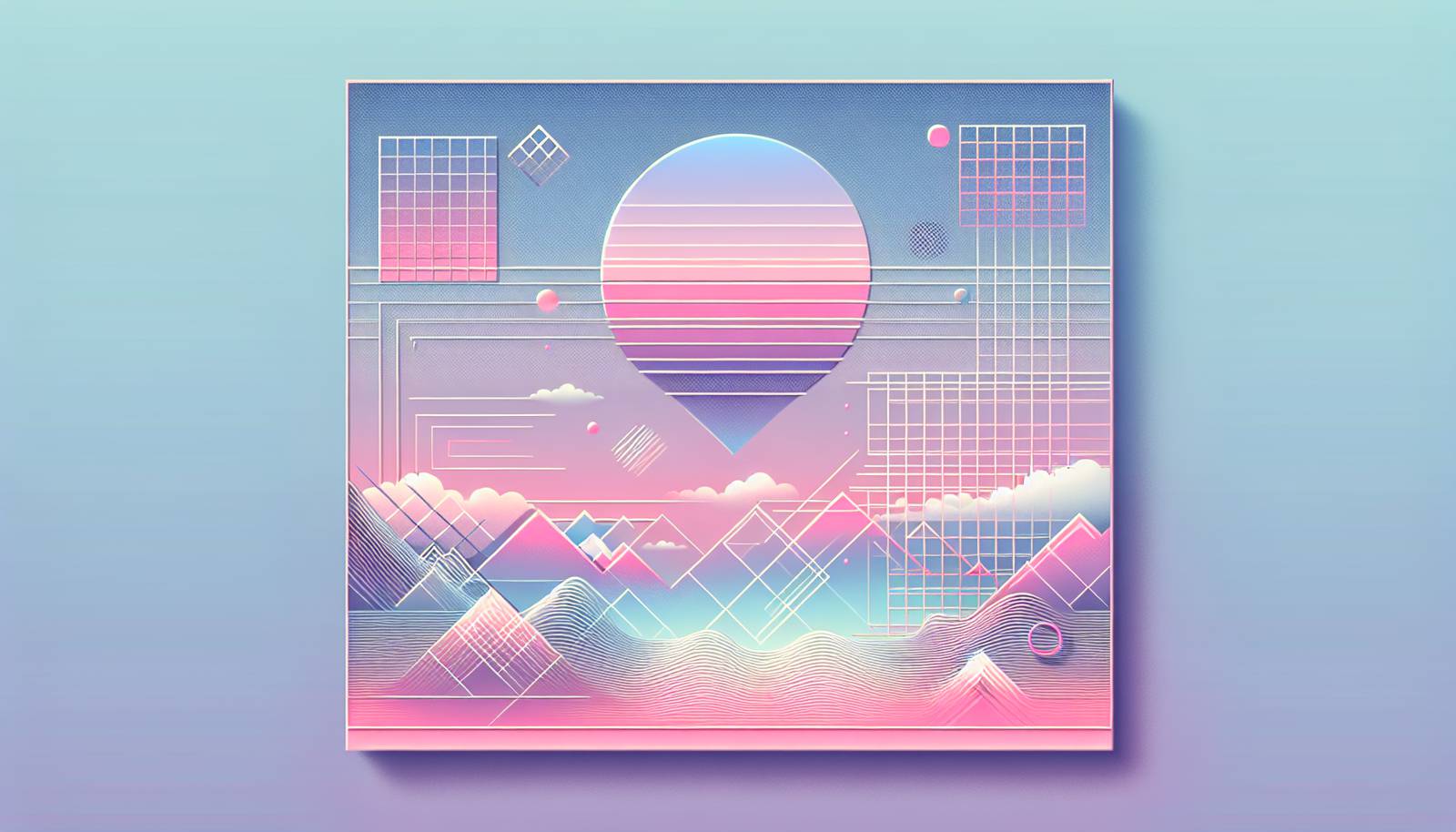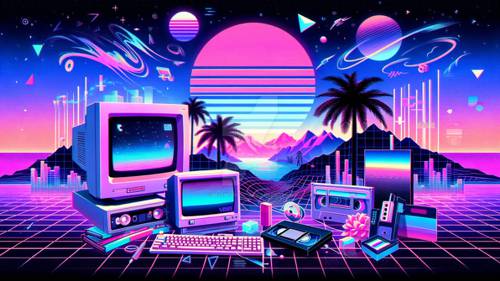
FAQ About The Influence of Vaporwave Aesthetics

What is vaporwave aesthetics?
Vaporwave aesthetics is a visual and musical style that combines elements of cyberpunk culture, synthesized music, and nostalgic retro influences from the 1980s and 1990s. It features dreamlike imagery, glitch art, and surreal visuals often inspired by early digital technology, anime, and consumer culture.

What elements define the music in vaporwave?
Vaporwave music typically features a slow-paced, surreal sound that is created through the manipulation and remixing of samples from 1980s and 1990s pop, jazz, and elevator music. This genre might include effects like reversing, pitch-up or pitch-down, and a lo-fi sound quality to evoke nostalgia.

How has vaporwave influenced modern fashion?
Vaporwave has left a significant mark on modern fashion by inspiring a trend towards retro-futuristic aesthetics. This includes the use of pastel colors, neon lights, and bold, graphic-inspired prints reminiscent of the 80s and 90s. Clothing brands often incorporate these themes into their designs to evoke nostalgia.

What are some common visual themes in vaporwave art?
Common themes in vaporwave art include the use of neon pinks, blues, and teals. The artwork often includes retro computer graphics, ancient Roman busts, glitch art, vapor-like textures, and nostalgic motifs such as palm trees and sunsets, often inspired by early internet and video game visuals.

Why do people find vaporwave aesthetics appealing?
People find vaporwave aesthetics appealing because it provides a unique blend of nostalgia and futuristic imagination. It allows viewers and listeners to reminisce about past technological optimism and consumer culture through a modern lens. This aesthetic also provides an escape into a dreamy, surreal environment.

What is the history behind the vaporwave movement?
The vaporwave movement began in the early 2010s as an internet-based microgenre. It evolved from earlier genres like chillwave and synthwave, drawing heavy inspiration from consumer culture, retro computer and internet graphics, and 80s and 90s commercial music. It has since grown into a global subculture.

How does vaporwave connect to cyberpunk culture?
Vaporwave connects to cyberpunk culture through its exploration of futuristic and dystopian themes. Both aesthetics share a fascination with technology and digital media, albeit vaporwave focuses more on nostalgia and consumer culture than the darker, more rebellious elements of cyberpunk.

In what ways has vaporwave impacted global aesthetics?
Vaporwave has impacted global aesthetics by influencing digital art, music, and fashion worldwide. It has encouraged creators to experiment with retro-futuristic and nostalgic themes, blending them into modern culture. As a result, vaporwave has become a prevalent cultural reference across various forms of media.

Are there any notable vaporwave artists?
Some notable vaporwave artists include Vektroid (known for the album Floral Shoppe), Saint Pepsi, and 2814. These artists have significantly contributed to the genre's growth and have become iconic figures in the vaporwave movement through their innovative use of sampling and unique soundscapes.

How have digital platforms played a role in vaporwave's expansion?
Digital platforms such as Bandcamp, SoundCloud, and YouTube have played crucial roles in vaporwave's expansion by providing accessible platforms for artists to share and distribute their work. These platforms have enabled the rapid spread and evolution of vaporwave culture, fostering a global community of fans and creators.

What role does nostalgia play in vaporwave?
Nostalgia is a central theme in vaporwave, as it repurposes sounds and visuals from the past to evoke sentimental feelings. By remixing and altering content from a bygone era, vaporwave creates a sense of longing for a perceived simpler time, which resonates with many contemporary audiences.

What is the significance of the term 'vapor' in vaporwave?
The term 'vapor' in vaporwave may refer to the ethereal, fleeting nature of the aesthetic, similar to how vapor disperses in the air. It suggests intangibility and a dreamlike quality, emphasizing the transient and surreal aspects of the art style.

How do vaporwave aesthetics appear in video games?
Vaporwave aesthetics appear in video games through their use of retro graphics, neon colors, and surreal environments, creating nostalgic and immersive experiences. Games like Hotline Miami and Sonic Dreams Collection exhibit vaporwave elements, offering players a visually reminiscent journey through past digital landscapes.

Is vaporwave still relevant today?
Yes, vaporwave remains relevant as it continues to influence a variety of creative fields, including music, film, digital art, and fashion. Its adaptability and nostalgic appeal make it a continuously evolving aesthetic that resonates with audiences across different cultures and age groups.

How do artists typically create vaporwave music?
Artists typically create vaporwave music by sampling tracks from the 1980s and 1990s, altering their pitch, tempo, and rhythm to create a new, dreamlike audio experience. They often incorporate synthesizers and minimalistic beats to enhance the nostalgic and surreal quality of the music.

What misconceptions exist about vaporwave?
One common misconception about vaporwave is that it's merely a 'meme genre' without serious artistic intent. While it has humorous and satirical elements, many artists and fans appreciate vaporwave for its unique exploration of nostalgia, aesthetics, and cultural commentary.

How has vaporwave influenced digital art communities?
Vaporwave has greatly influenced digital art communities by inspiring artists to experiment with nostalgic and surreal imagery. The aesthetic encourages the use of retro technology, glitch art, and dreamlike visuals, promoting innovative art forms that challenge traditional norms.

What is the connection between vaporwave and memetics?
Vaporwave and memetics are connected through their use of internet culture and irony. Vaporwave often employs satire of consumerism and nostalgia, paralleling how memes use humor and criticism to comment on modern society, making both highly relevant in contemporary digital discourse.

Can vaporwave be considered a form of rebellion?
Vaporwave can be considered a form of rebellion in its critique of consumer culture and mainstream music. By repurposing and distorting corporate sounds and visuals, vaporwave artists often subvert traditional cultural norms, making it a subtle yet impactful form of artistic protest.

How has vaporwave evolved since its inception?
Since its inception, vaporwave has evolved from a niche internet subculture into a broader artistic movement. It has diversified into various subgenres and inspired new styles in both music and visual art, continually adapting to incorporate contemporary themes and technologies.
